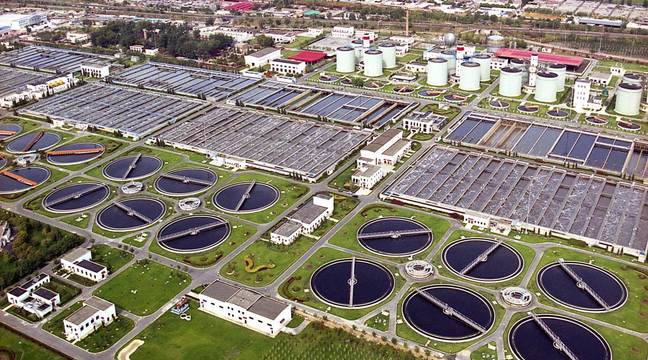
当前课程知识点:Water and Wastewater Treatment Engineering: Biochemical Technology > Chapter 2 Activated sludge process > Section 2.4 Kinetics of active sludge process > Section 2.4.3 Kinetics of active sludge process(3)
返回《Water and Wastewater Treatment Engineering: Biochemical Technology》慕课在线视频课程列表
返回《Water and Wastewater Treatment Engineering: Biochemical Technology》慕课在线视频列表
有了前两个导出方程以后,我们关心的是如何维持曝气池中间的污泥浓度
当然通过前面的介绍
我们已经知道了这个为了维持曝气池中间稳定的污泥浓度
我们需要让混合液进入二沉池进行沉淀并且进行浓缩提高污泥浓度
再通过一个污泥回流,回到曝气池来维持曝气池中间稳定的浓度
因此,我们第三个导出方程就是为了
推导污泥的回流比R跟污泥龄之间的关系
同样,我们对这个曝气池中间的生物量进行物料的恒算
可以得到这样的一个公式
可以看到,通过一系列的数学替换
代换以后我们就可以得到最终这个表达方程
这个关系式,我们可以看到
这个R跟哪些值有关呢?
首先跟你的θc有关,跟你的流量,跟你的体积
曝气池体积,还跟污泥的浓度,跟回流污泥的浓度的比有关
其中的Xr,当然有的时候我们可以用10的6次方除以SVI来表示
关于这一点,我们在前面已经特别介绍过
为什么能够用这个公式来进行计算Xr
请大家回去呢,再去复习一下
因此有了第三个导出方程,我们就可以方便的知道
通过计算以后,就能求出这个较合适的回流比
第四个导出方程是关于产率系数跟表观产率系数之间的关系
在这呢,我们就简单的重复一下
这个产率系数是指的在前面我们讲
有机物的合成的过程中间,在第一步合成的过程中间,它合成的这个产率系数
而表观产率系数,是加上了内原呼吸
或者说是扣除了内原呼吸对污泥量的减少的这部分作用以后
实际的这个产率系数
因此我们可以看
产率系数是指在单位时间内微生物的合成的量跟基质的降解量之间的比值
可以用这个公式来表达,而表观产率系数
是指单位时间内实际测定的污泥的产量跟基质的降解量之间的比值
可以用这个关系来表示,所以我们可以看到
这个所谓的表观产率系数实际上是等于μ除上q
我们可以在这呢,进行一系列的推导
通过这个推导以后呢,我们就会会发现
这个表观产率系数和产率系数之间的关系,可以用这个公式来表达
从这个公式中间呢,我们可以看到
表观产率系数呢,实际上是跟污泥龄和自身氧化系数密切相关
这个公式,实际上还提供了一种通过实验来求取两个动力学常数
一个是Y,一个是Kd的办法
我们可以把上面的公式做一定的变换,就得到这样的一个公式
这个公式,我们可以看到
表观产率系数分之一和θc,是成直线的关系
对它进行作图,就可以求得这个Y和Kd
最后一个导出方程是关于这个θc跟出水水质,或者说是跟去除率的关系
在第一个导出方程中间,我们已经发现θc对于活性污泥系统至关重要
它可以直接地影响出水水质
因此的话,在运行一个曝气池或者运行一个活性污泥系统中间
我希望能够达到比较好的一个出水水质
那我需要设定一个比较好的,比较合适的污泥龄
我希望能够知道,在对一个活性污泥系统中有没有
或者说存不存在一个最小的污泥龄
我们可以看到呢,对于一个活性污泥系统来说
它确实存在一个最小的污泥龄
我们可以假设,在这样的一个方程中间
假设它的出水水质跟进水水质完全相等的时候
这个时候所求得的这个污泥龄就相当于这个系统的最小的污泥龄
因为,它已经对这个进水的水质
没有任何的去除作用,说明污泥龄太小
我们代入以后就可以得到这样的一个关系式,可以用这个公式来表示
通常情况下,这个Ks也就是所谓的半速常数,或者半饱和常数
是会远小于这个系统进水的水质的
也就是Ks呢,会远小于Si
所以,我们可以把上面的这个公式简单的简化一下
最小的污泥龄,就可以用这个公式来进行表达
它实际是由这个系统的三个动力学常数即Y,vmax和Kd
直接能够计算求得
有了这个最小的污泥龄,我们就可以看到这样的一个图示
从这个图上,我们可以看到
当这个系统的污泥龄如果小于了最小的这个污泥龄的时候
它的出水水质跟进水水质相等,它的去除率就接近于0
而当这个θc,系统的θc大于这个最小的这个θc的话
水质逐渐得到改善
当这个θc达到一定的值以后,它的出水水质就基本稳定
在一个比较低的水平
而相应的去除率呢,就会达到一个相对较高的水平
我们刚刚介绍完了这个L-M模型
我们知道,在这个活性污泥系统中间
如果我们能够确定这四个动力学参数,Ks,v_max和Y,以及Kd
那我们就能够通过一些理论计算
能够非常方便的计算出我们所能够达到的出水水质
我们所需要的污泥浓度,我们所需要的回流比
因此呢,就提出一个新的问题
就关于这个动力学参数的这个确定,或者说是测定
一般来说呢,它可以通过实验的方法来进行确定
具体的这个测定方法,我们请同学自己去参考我们附件中间的一些这个说明
最后呢,我们来简单的总结一下
活性污泥法动力学中的一些主要的公式
我们首先看,莫诺德模型,实际上是有两个基本的方程
一个是关于这个μ,一个是关于这个v
当然在我们的废水处理中间,关于这个v的这个公式更加的重要
因为它表示的是有机物或者说是污染物质的降解的情况
它有两个推论,一个推论是高基质浓度下,一个是低基质浓度下
我们可以看到呢,在高基质浓度下,底物的降解速率主要跟污泥浓度有关
而不受基质浓度的影响
而在低基质浓度下
它不仅跟微生物的浓度有关,还跟基质浓度有关
其次呢就是Lawrence-McCarty模式
这个模型,我们首先有一系列的基本概念
这些基本概念呢,希望大家能够非常清楚
它的具体的定义和它的计算
其次它有两个基本方程
这两个基本方程呢,一个是关于θc,一个是认同莫诺德模型
然后给出的这样一个基质降解的速率受X和基质浓度的影响
然后在这两个基本方程的基础上,我们有五个导出方程
分别计算的是出水水质,污泥浓度,回流比
以及表观污泥产率系数,以及最小污泥龄
希望大家能够想清楚,能够把它们进行推导
实际上,活性污泥法的应用在实际中有很多
在国际的这个IWA,也就是国际水协会
他们专门成立了这个工作组,专门推导了活性污泥的模型,也就是ASM
有一系列的模型,有ASM1、ASM2、以及2D、以及3
这些模型的一些基本的内容,或者说更细致一部分的这个介绍
请同学参考有关的资料
好,这节内容就到这,谢谢大家
-Section 0.1 Development Status of Wastewater Treatment Process
--Section 0.1 Development Status of Wastewater Treatment Process
-Section 0.2 Typical Processes of Wastewater Biological Treatment
--Section 0.2 Typical Processes of Wastewater Biological Treatment
-Section 1.1 Principles of wastewater aerobic biological treatment
--1.1 Principles of wastewater aerobic biological treatment
-Section 1.2 Principles and determination of wastewater biodegradability
--1.2 Principles and determination of wastewater biodegradability
-Section 1.3 Principles of wastewater anaerobic biological treatment
--Section 1.3.1 Principles of wastewater anaerobic biological treatment(1)
--Section 1.3.2 Principles of wastewater anaerobic biological treatment(2)
-Section 1.4 Principles of wastewater biological nitrogen removal
--Section 1.4 Principles of wastewater biological nitrogen removal
-Section 1.5 Principles of wastewater biological phosphorus removal
--Section 1.5 Principles of wastewater biological phosphorus removal
-Chapter 1 Homework
-Section 2.1 Basic concept of activated sludge process
--Section 2.1.1 Basic concept of activated sludge process
--Section 2.1.2 Basic concept of activated sludge process
-Section 2.2 Growth rule of activated sludge and its application
--Section 2.2 Growth rule of activated sludge and its application
-Section 2.3 Running mode of activated sludge process
--Section 2.3.1 Running mode of activated sludge process(1)
--Section 2.3.2 Running mode of activated sludge process(2)
-Section 2.4 Kinetics of active sludge process
--Section 2.4.1 Kinetics of active sludge process(1)
--Section 2.4.2 Kinetics of active sludge process(2)
--Section 2.4.3 Kinetics of active sludge process(3)
--Research and Development of Kinetic Model of Activated Sludge Process
-Section 2.5 Principle, calculation and equipment of aeration
--Section 2.5.1 Principle, calculation and equipment of aeration(1)
--Section 2.5.2 Principle, calculation and equipment of aeration(2)
-Section 2.6 Designing of activated sludge process
--Section 2.6 Designing of activated sludge process
-Section 2.7 Operation and management of active sludge process
--Section 2.7.1 Operation and management of active sludge process (1)
--Section 2.7.2 Operation and management of active sludge process (2)
-Chapter 2 Homework
-Section 3.1 Basic principle of biofilm
--Section 3.1 Basic principle of biofilm
-Section 3.2 Biofilter process
--Section 3.2.1 Biofilter Process (1)
--Section 3.2.2 Biofilter process (2)
--Section 3.2.3 Biofilter process (3)
-Section 3.3 Biodisk process
-Section 3.4 Biological contact oxidation process
--Section 3.4 Biological contact oxidation process
-Section 3.5 Aerobic biological fluidized bed process
--Section 3.5 Aerobic biological fluidized bed process
-Chapter 3 Homework
-Section 4.1 Oxidation ditch process
--Section 4.1 Oxidation ditch process
-Section 4.2 A-B process
-Section 4.3 SBR process
-Section 4.4 MBR process
-Chapter 4 Homework
-Section 5.1 Overview and characteristics of development of anaerobic biological treatment
--Section 5.1 Overview and characteristics of development of anaerobic biological treatment
-Section 5.2 Anaerobic digester
--Section 5.2 Anaerobic digester
-Section 5.3 Anaerobic contact process and anaerobic filter process
--Section 5.3 Anaerobic contact process and anaerobic filter process
-Section 5.4 UASB process
-Section 5.5 Other anaerobic biological treatment process
--Section 5.5 Other anaerobic biological treatment process
-Section 5.6 Operation management of anaerobic biological treatment process
--Section 5.6 Operation management of anaerobic biological treatment process
-Chapter 5 Homework
-Section 6.1 Introduction
-Section 6.2 Biological nitrogen removal process and technology
--Section 6.2 Biological nitrogen removal process and technology
-Section 6.3 Biological phosphorus removal process and technology
--Section 6.3 Biological phosphorus removal process and technology
-Section 6.4 Simultaneous nitrogen and phosphorus removal process
--Section 6.4 Simultaneous nitrogen and phosphorus removal process
-Chapter 6 Homework
-Section 7 Natural biological treatment process
--Section 7 Natural biological treatment process
-Chapter 7 Homework
-Section 8.1 Source, nature and treatment of sludge
--Section 8.1 Source, nature and treatment of sludge
-Section 8.2 Sludge thickening and digestive stability
--Section 8.2 Sludge thickening and digestive stability
-Section 8.3 Sludge conditioning, dehydration and incineration
--Section 8.3 Sludge conditioning, dehydration and incineration
-Chapter 8 Homework
-Section 9 Wastewater Discharge and Reuse
--Section 9 Wastewater Discharge and Reuse
-Chapter 9 Homework

